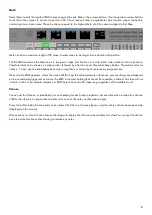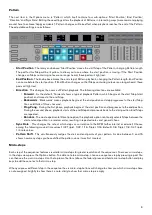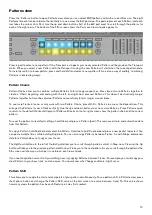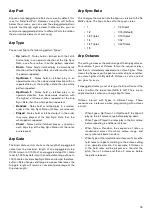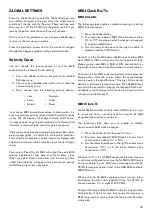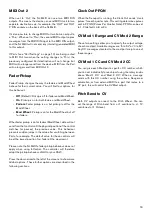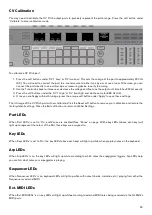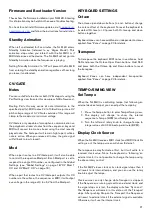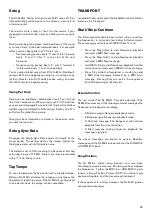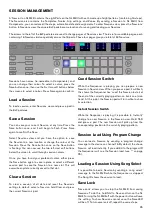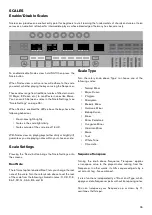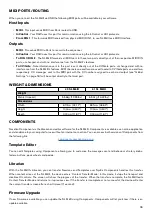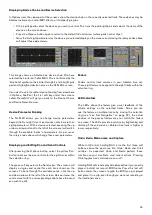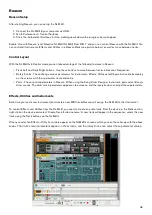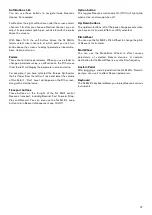
22
Swing
The SL MkIII’s Swing function moves MIDI notes off their
mathematically precise positions to achieve a more natural
or human sound .
The result is more ‘swing’ or ‘feel’ . In other words, if your
arpeggios or patterns feel rigid, try adding some swing to
them .
Swing works by pushing even-numbered beats of the swing
sync rate closer to the odd-numbered beats . For example,
with a common beat pattern of ‘1-2-3-4-1’ etc .:
• Positive swing pushes beats ‘2’ and ‘4’ later, towards
beats ‘3’ and ‘1’ (this ‘1’ is the start of the next
measure) .
• Negative swing pushes beats ‘2’ and ‘4’ forward in
time towards beats ‘1’ and ‘3’ respectively .
You can adjust global swing from 20% to 80% . By default,
swing is 50%, which applies no swing (i .e ., no change in the
rhythm) . Greater than 50% adds positive swing, and less
than 50% results in negative swing .
Swing Per Track
Swing can be enabled or disabled per track . You can find
this in the Tempo menu . When swing is set to ‘Off’, both the
sequencer and arpeggiator steps for that track will not follow
global swing (it will default to 50% swing) . Tracks set to ‘On’
will follow the global Swing value .
Swing per track information is stored in the session when
you save that session .
Swing Sync Rate
Changing the Swing Sync Rate adjusts the length of the
swing period . The setting defines the tempo interval the
Swing parameter will shift alternate notes .
The default is set to 1/16, meaning the Sequencer and Arp
will swing in pairs of 1/16ths . Triplet sync rates are denoted
with a “T” after the sync rate .
Tap Tempo
To set a tempo press the Tap button at the intended tempo .
Before a SL MkIII calculates the tempo you must press the
Tap button at least three times . If the SL MkIII is synchronised
to an external clock, tap tempo will be unavailable .
TRANSPORT
Located at the far-right side of the SL MkIII is a row of buttons
known as the ‘Transport’ .
Start/Stop/Continue
The following points explain how to start, stop or continue
the Sequencer in all modes (excluding InControl mode) .
These messages will only send if MIDI Clock Tx is on:
• Press the Play button to start Sequencer playback
and send a MIDI Start message .
• Press the Stop button to stop Sequencer playback
and send a MIDI Stop message .
• Hold Shift + Play to start Sequencer playback from the
current position and send a MIDI Continue message .
• Press Play while the Sequencer is running to send
a MIDI Stop message followed by a MIDI Start
message . Pressing Play will restart the sequencer
from the beginning of the Session .
External Control
You can control The SL MkIII’s Transport externally . If the
SL MkIII receives any of the following external messages the
Sequencer will respond accordingly:
• A Start message: Sequencer playback starts .
• A Stop message: Sequencer playback stops .
• A Continue message: The Sequencer will continue
playback from the current position .
• A Start message during sequencer playback: the
message is ignored .
The above messages are known as system Real-time
messages and the SL MkIII receives them at the DIN MIDI In
or USB MIDI In ports .
Song Position
The SL MkIII’s internal song position can also move
according to an external source . Providing you have stopped
the Sequencer, if either the MIDI In or USB MIDI In ports
receive a Song Position Pointer (SPP) the internal song
position will update, and the message will retransmit .
If the sequencer is running, however, the SL MkIII ignores
song position messages .

